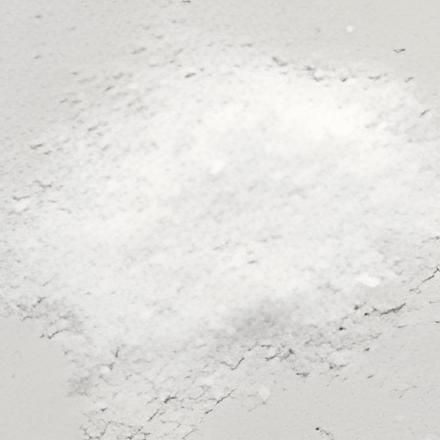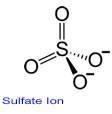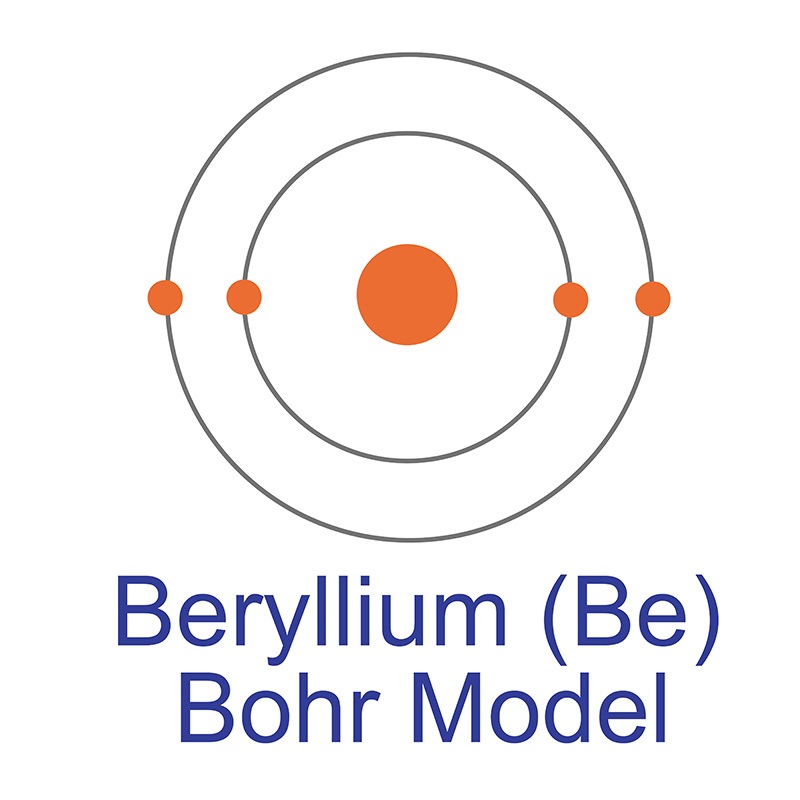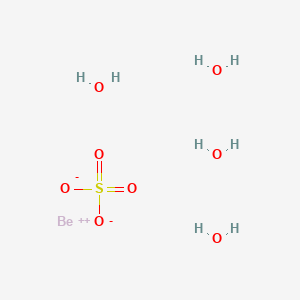SECTION 1. IDENTIFICATION
Product Name: Beryllium Sulfate Tetrahydrate
Product Number: All applicable American Elements product codes, e.g. BE-SAT-02-C.4HYD
, BE-SAT-03-C.4HYD
, BE-SAT-04-C.4HYD
, BE-SAT-05-C.4HYD
CAS #: 7787-56-6
Relevant identified uses of the substance: Scientific research and development
Supplier details:
American Elements
10884 Weyburn Ave.
Los Angeles, CA 90024
Tel: +1 310-208-0551
Fax: +1 310-208-0351
Emergency telephone number:
Domestic, North America: +1 800-424-9300
International: +1 703-527-3887
SECTION 2. HAZARDS IDENTIFICATION
Classification of the substance or mixture
GHS Classification in accordance with 29 CFR 1910 (OSHA HCS)
Acute toxicity, Oral (Category 3), H301
Acute toxicity, Inhalation (Category 2), H330
Skin irritation (Category 2), H315
Eye irritation (Category 2A), H319
Skin sensitisation (Category 1), H317
Carcinogenicity (Category 1B), H350
Specific target organ toxicity - single exposure (Category 3), Respiratory system, H335
Specific target organ toxicity - repeated exposure (Category 1), H372
Acute aquatic toxicity (Category 2), H401
Chronic aquatic toxicity (Category 2), H411
GHS Label elements, including precautionary statements
Pictogram
Signal word Danger
Hazard statement(s)
H301 Toxic if swallowed.
H315 Causes skin irritation.
H317 May cause an allergic skin reaction.
H319 Causes serious eye irritation.
H330 Fatal if inhaled.
H335 May cause respiratory irritation.
H350 May cause cancer.
H372 Causes damage to organs through prolonged or repeated exposure.
H411 Toxic to aquatic life with long lasting effects.
Precautionary statement(s)
P201 Obtain special instructions before use.
P202 Do not handle until all safety precautions have been read and
understood.
P260 Do not breathe dust/ fume/ gas/ mist/ Vapors/ spray.
P264 Wash skin thoroughly after handling.
P270 Do not eat, drink or smoke when using this product.
P271 Use only outdoors or in a well-ventilated area.
P272 Contaminated work clothing should not be allowed out of the workplace.
P273 Avoid release to the environment.
P280 Wear protective gloves/ protective clothing/ eye protection/ face
protection.
P284 Wear respiratory protection.
P301 + P310 + P330 IF SWALLOWED: Immediately call a POISON CENTER/doctor. Rinse
mouth.
P302 + P352 IF ON SKIN: Wash with plenty of soap and water.
P304 + P340 + P310 IF INHALED: Remove person to fresh air and keep comfortable for
breathing. Immediately call a POISON CENTER/doctor.
P305 + P351 + P338 IF IN EYES: Rinse cautiously with water for several minutes. Remove
contact lenses, if present and easy to do. Continue rinsing.
P308 + P313 IF exposed or concerned: Get medical advice/ attention.
P333 + P313 If skin irritation or rash occurs: Get medical advice/ attention.
P337 + P313 If eye irritation persists: Get medical advice/ attention.
P362 Take off contaminated clothing and wash before reuse.
P391 Collect spillage.
P403 + P233 Store in a well-ventilated place. Keep container tightly closed.
P405 Store locked up.
P501 Dispose of contents/ container to an approved waste disposal plant.
Hazards not otherwise classified (HNOC) or not covered by GHS - none
SECTION 3. COMPOSITION/INFORMATION ON INGREDIENTS
Substances
Formula : BeO4S · 4H2O
Molecular weight : 177.14 g/mol
CAS-No. : 7787-56-6
EC-No. : 236-842-2
Index-No. : 004-002-00-2
Hazardous components
Component
Beryllium sulfate tetrahydrate
Classification
Acute Tox. 3; Acute Tox. 2; Skin Irrit. 2; Eye Irrit. 2A; Skin Sens. 1; Carc. 1B; STOT SE 3; STOT RE 1; Aquatic Acute 2; Aquatic Chronic 2; H301, H315, H317, H319, H330, H335, H350, H372, H411
Concentration
90 - 100 %
SECTION 4. FIRST AID MEASURES
Description of first aid measures
General advice
Consult a physician. Show this safety data sheet to the doctor in attendance. Move out of dangerous area.
If inhaled
If breathed in, move person into fresh air. If not breathing, give artificial respiration. Consult a physician.
In case of skin contact
Wash off with soap and plenty of water. Take victim immediately to hospital. Consult a physician.
In case of eye contact
Rinse thoroughly with plenty of water for at least 15 minutes and consult a physician.
If swallowed
Never give anything by mouth to an unconscious person. Rinse mouth with water. Consult a physician.
Most important symptoms and effects, both acute and delayed
The most important known symptoms and effects are described in the labelling (see section 2.2) and/or in section 11
Indication of any immediate medical attention and special treatment needed
No data available
SECTION 5. FIREFIGHTING MEASURES
Extinguishing media
Suitable extinguishing media
Use water spray, alcohol-resistant foam, dry chemical or carbon dioxide.
Special hazards arising from the substance or mixture
No data available
Advice for firefighters
Wear self-contained breathing apparatus for firefighting if necessary.
Further information
No data available
SECTION 6. ACCIDENTAL RELEASE MEASURES
Personal precautions, protective equipment and emergency procedures
Wear respiratory protection. Avoid dust formation. Avoid breathing Vapors, mist or gas. Ensure adequate ventilation.
Evacuate personnel to safe areas. Avoid breathing dust.
For personal protection see section 8.
Environmental precautions
Prevent further leakage or spillage if safe to do so. Do not let product enter drains. Discharge into the environment
must be avoided.
Methods and materials for containment and cleaning up
Pick up and arrange disposal without creating dust. Sweep up and shovel. Keep in suitable, closed containers for
disposal.
Reference to other sections
For disposal see section 13.
SECTION 7. HANDLING AND STORAGE
Precautions for safe handling
Avoid contact with skin and eyes. Avoid inhalation of Vapor or mist.
Use explosion-proof equipment.Keep away from sources of ignition - No smoking.Take measures to prevent the build
up of electrostatic charge.
For precautions see section 2.2.
Conditions for safe storage, including any incompatibilities
Keep container tightly closed in a dry and well-ventilated place. Containers which are opened must be carefully
resealed and kept upright to prevent leakage.
Never allow product to get in contact with water during storage. Do not store near acids.
Handle and store under inert gas. Handle and open container with care. Air sensitive.
Storage class (TRGS 510): Flammable liquids
Specific end use(s)
No other specific uses are stipulated
SECTION 8. EXPOSURE CONTROLS/PERSONAL PROTECTION
Control parameters
Components with workplace control parameters
Component / CAS-No.
Beryllium sulfate tetrahydrate / 7787-56-6
Value / Control parameters / Basis
TWA / 2.00 μg/m3 / USA. Occupational Exposure Limits(OSHA) - Table Z-2 (Remarks: Z27.29-1970)
CEIL / 5.00 μg/m3 / USA. Occupational Exposure Limits (OSHA) - Table Z-2 (Remarks: Z27.29-1970)
Peak / 25.00 μg/m3 / USA. Occupational Exposure Limits (OSHA) - Table Z-2 (Remarks: Z27.29-1970)
TWA / 0.000050 mg/m3 / USA. ACGIH Threshold Limit Values (TLV)
Beryllium sensitization
Chronic beryllium disease (berylliosis)
Confirmed human carcinogen
Danger of cutaneous absorption
Sensitizer
TWA / 0.000050 mg/m3 / USA. ACGIH Threshold Limit Values (TLV)
Beryllium sensitization
Chronic beryllium disease (berylliosis)
Adopted values or notations enclosed are those for which changes
are proposed in the NIC
See Notice of Intended Changes (NIC)
Confirmed human carcinogen
Danger of cutaneous absorption
Sensitizer
C / 0.000500 mg/m3 / USA. NIOSH Recommended Exposure Limits (Remarks: Potential Occupational Carcinogen; See Appendix A. See Table Z-2)
TWA / 2.000000 μg/m3 / USA. Occupational Exposure Limits (OSHA) - Table Z-2 (Remarks: Z27.29-1970)
CEIL / 5.000000 μg/m3 / USA. Occupational Exposure Limits (OSHA) - Table Z-2 (Remarks: Z27.29-1970)
Peak / 25.000000 μ/m3 / USA. Occupational Exposure Limits (OSHA) - Table Z-2 (Remarks: Z27.29-1970; See Table Z-2)
TWA / 2 microgram per cubic meter / USA. Occupational Exposure Limits (OSHA) - Table Z-2 (Remarks: Z27.29-1970)
CEIL / 5 microgram per cubic meter / USA. Occupational Exposure Limits (OSHA) - Table Z-2 (Remarks: Z27.29-1970)
Peak 25 microgram per cubic meter / USA. Occupational Exposure Limits (OSHA) - Table Z-2 (Remarks: Z27.29-1970)
C / 0.0005 mg/m3 / USA. NIOSH Recommended Exposure Limits (Remarks: Potential Occupational Carcinogen; See Appendix A.)
PEL / 0.0002 mg/m3 / California permissible exposure limits for chemical contaminants (Title 8, Article 107)
C / 0.025 mg/m3 / California permissible exposure limits for chemical contaminants (Title 8, Article 107)
Exposure controls
Appropriate engineering controls
Avoid contact with skin, eyes and clothing. Wash hands before breaks and immediately after handling the product.
Personal protective equipment
Eye/face protection
Face shield and safety glasses Use equipment for eye protection tested and approved under appropriate
government standards such as NIOSH (US) or EN 166(EU).
Skin protection
Handle with gloves. Gloves must be inspected prior to use. Use proper glove removal technique (without
touching glove's outer surface) to avoid skin contact with this product. Dispose of contaminated gloves after
use in accordance with applicable laws and good laboratory practices. Wash and dry hands.
Body Protection
Complete suit protecting against chemicals, The type of protective equipment must be selected according to
the concentration and amount of the dangerous substance at the specific workplace.
Respiratory protection
Where risk assessment shows air-purifying respirators are appropriate use a full-face particle respirator type
N100 (US) or type P3 (EN 143) respirator cartridges as a backup to engineering controls. If the respirator is the
sole means of protection, use a full-face supplied air respirator. Use respirators and components tested and
approved under appropriate government standards such as NIOSH (US) or CEN (EU).
Control of environmental exposure
Prevent further leakage or spillage if safe to do so. Do not let product enter drains. Discharge into the
environment must be avoided.
SECTION 9. PHYSICAL AND CHEMICAL PROPERTIES
Appearance
Form: crystalline
Colour: white
Odor No data available
Odor Threshold No data available
pH: No data available
Melting point/range: 550 - 600 °C (1,022 - 1,112 °F)
Initial boiling point and boiling range: No data available
Flash point: Not applicable
Evaporation rate: No data available
Flammability (solid, gas): No data available
Upper/lower flammability or explosive limits: No data available
Vapor pressure: No data available
Vapor density: No data available
Relative density: 1.713 g/cm3 at 25 °C (77 °F)
Water solubility: No data available
Partition coefficient: noctanol/water: No data available
Auto-ignition temperature: No data available
Decomposition temperature: No data available
Viscosity: No data available
Explosive properties: No data available
Oxidizing properties: No data available
Other safety information
No data available
SECTION 10. STABILITY AND REACTIVITY
Reactivity
No data available
Chemical stability
Stable under recommended storage conditions.
Possibility of hazardous reactions
No data available
Conditions to avoid
No data available
Incompatible materials
Strong oxidizing agents
Hazardous decomposition products
Hazardous decomposition products formed under fire conditions. - Sulphur oxides, Beryllium oxides
Other decomposition products - No data available
In the event of fire: see section 5
SECTION 11. TOXICOLOGICAL INFORMATION
Information on toxicological effects
Acute toxicity
LD50 Oral - Rat - 82 mg/kg
Dermal: No data available
No data available
Skin corrosion/irritation
No data available
Serious eye damage/eye irritation
No data available
Respiratory or skin sensitisation
Germ cell mutagenicity
Human
lymphocyte
Cytogenetic analysis
Human
lymphocyte
Sister chromatid exchange
Hamster
Embryo
Cytogenetic analysis
Hamster
Embryo
Morphological transformation.
Hamster
Embryo
Sister chromatid exchange
Rat
Other mutation test systems
Carcinogenicity
Carcinogenicity - Rat - Inhalation
Tumorigenic: Carcinogenic by RTECS criteria. Lungs, Thorax, or Respiration:Tumors.
Possible human carcinogen
IARC: 1 - Group 1: Carcinogenic to humans (Beryllium sulfate tetrahydrate)
NTP: Known - Known to be human carcinogenThe reference note has been added by TD based on the background information of the NTP. (Beryllium sulfate tetrahydrate)
OSHA: No component of this product present at levels greater than or equal to 0.1% is identified as a carcinogen or potential carcinogen by OSHA.
Reproductive toxicity
No data available
No data available
Specific target organ toxicity - single exposure
May cause respiratory irritation.
Specific target organ toxicity - repeated exposure
Causes damage to organs through prolonged or repeated exposure.
Aspiration hazard
No data available
Additional Information
RTECS: DS5000000
SECTION 12. ECOLOGICAL INFORMATION
Toxicity
No data available
Persistence and degradability
Biodegradability Result: - Not readily biodegradable.
Bioaccumulative potential
No data available
Mobility in soil
No data available
Results of PBT and vPvB assessment
PBT/vPvB assessment not available as chemical safety assessment not required/not conducted
Other adverse effects
Toxic to aquatic life with long lasting effects.
An environmental hazard cannot be excluded in the event of unprofessional handling or disposal.
SECTION 13. DISPOSAL CONSIDERATIONS
Waste treatment methods
Product
Offer surplus and non-recyclable solutions to a licensed disposal company. Contact a licensed professional waste
disposal service to dispose of this material. Dissolve or mix the material with a combustible solvent and burn in a
chemical incinerator equipped with an afterburner and scrubber.
Contaminated packaging
Dispose of as unused product.
SECTION 14. TRANSPORT INFORMATION
DOT (US)
UN number: 1566 Class: 6.1 Packing group: II
Proper shipping name: Beryllium compounds, n.o.s. (Beryllium sulfate tetrahydrate)
Reportable Quantity (RQ):
Poison Inhalation Hazard: No
IMDG
UN number: 1566 Class: 6.1 Packing group: II EMS-No: F-A, S-A
Proper shipping name: BERYLLIUM COMPOUND, N.O.S. (Beryllium sulfate tetrahydrate)
Marine pollutant:yes
IATA
UN number: 1566 Class: 6.1 Packing group: II
Proper shipping name: Beryllium compound, n.o.s. (Beryllium sulfate tetrahydrate)
SECTION 15. REGULATORY INFORMATION
SARA 302 Components
No chemicals in this material are subject to the reporting requirements of SARA Title III, Section 302.
SARA 313 Components
The following components are subject to reporting levels established by SARA Title III, Section 313:
Beryllium sulfate tetrahydrate
CAS-No.
7787-56-6
Revision Date
1993-04-24
SARA 311/312 Hazards
Acute Health Hazard, Chronic Health Hazard
Massachusetts Right To Know Components
Beryllium sulfate tetrahydrate
CAS-No.
7787-56-6
Revision Date
1993-04-24
Pennsylvania Right To Know Components
Beryllium sulfate tetrahydrate
CAS-No.
7787-56-6
Revision Date
1993-04-24
Beryllium sulfate tetrahydrate
CAS-No.
7787-56-6
Revision Date
1993-04-24
New Jersey Right To Know Components
Beryllium sulfate tetrahydrate
CAS-No.
7787-56-6
Revision Date
1993-04-24
California Prop. 65 Components
WARNING! This product contains a chemical known to the
State of California to cause cancer.
Beryllium sulfate tetrahydrate
CAS-No.
7787-56-6
Revision Date
2007-09-28
SECTION 16. OTHER INFORMATION
Safety Data Sheet according to Regulation (EC) No. 1907/2006 (REACH). The above information is believed to be correct but does not purport to be all inclusive and shall be used only as a guide. The information in this document is based on the present state of our knowledge and is applicable to the product with regard to appropriate safety precautions. It does not represent any guarantee of the properties of the product. American Elements shall not be held liable for any damage resulting from handling or from contact with the above product. See reverse side of invoice or packing slip for additional terms and conditions of sale. COPYRIGHT 1997-2022 AMERICAN ELEMENTS. LICENSED GRANTED TO MAKE UNLIMITED PAPER COPIES FOR INTERNAL USE ONLY.


 The number of electrons in each of Beryllium's shells is [2, 2] and its electron configuration is [He] 2s2. The beryllium atom has a radius of 112 pm and a Van der Waals radius of 153 pm. Beryllium is a relatively rare element in the earth's crust; it can be found in minerals such as bertrandite, chrysoberyl, phenakite, and beryl, its most common source for commercial production. Beryllium was discovered by Louis Nicolas Vauquelin in 1797 and first isolated by Friedrich Wöhler and Antoine Bussy in 1828.
The number of electrons in each of Beryllium's shells is [2, 2] and its electron configuration is [He] 2s2. The beryllium atom has a radius of 112 pm and a Van der Waals radius of 153 pm. Beryllium is a relatively rare element in the earth's crust; it can be found in minerals such as bertrandite, chrysoberyl, phenakite, and beryl, its most common source for commercial production. Beryllium was discovered by Louis Nicolas Vauquelin in 1797 and first isolated by Friedrich Wöhler and Antoine Bussy in 1828.  In its elemental form, beryllium has a gray metallic appearance. It is a soft
In its elemental form, beryllium has a gray metallic appearance. It is a soft  The number of electrons in each of Sulfur's shells is 2, 8, 6 and its electron configuration is [Ne] 3s2 3p4. In its elemental form, sulfur has a light yellow appearance. The sulfur atom has a covalent radius of 105 pm and a Van der Waals radius of 180 pm. In nature, sulfur can be found in hot springs, meteorites, volcanoes, and as galena, gypsum, and epsom salts. Sulfur has been known since ancient times but was not accepted as an element until 1777, when Antoine Lavoisier helped to convince the scientific community that it was an element and not a compound.
The number of electrons in each of Sulfur's shells is 2, 8, 6 and its electron configuration is [Ne] 3s2 3p4. In its elemental form, sulfur has a light yellow appearance. The sulfur atom has a covalent radius of 105 pm and a Van der Waals radius of 180 pm. In nature, sulfur can be found in hot springs, meteorites, volcanoes, and as galena, gypsum, and epsom salts. Sulfur has been known since ancient times but was not accepted as an element until 1777, when Antoine Lavoisier helped to convince the scientific community that it was an element and not a compound.
